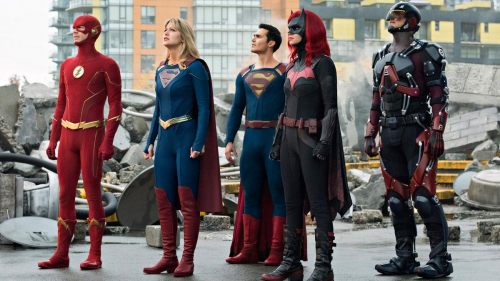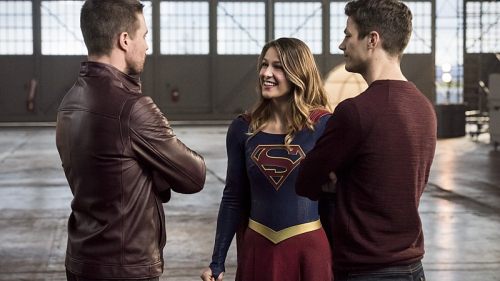DC’S LEGENDS OF TOMORROW Is Saving The Arrowverse’s Forgotten Cast
If you ask anyone familiar with the Arrowverse, they’ll most likely tell you they never expected Legends of Tomorrow to be as good as it is. The show started as a throwaway series for side characters from other Arrow-verse shows that could use more screentime but has evolved into a show where a gigantic Furby rip-off fights a demon in the Wild West. Beyond the crazy plot points, however, this has become a show about friendships. In season one, the best episodes were those that focused on the character interactions, and recently even the most minor member of the team has had more character development in side stories than they ever got in their shows of origin.
While The Flash mostly uses its CGI budget for Barry and the villain-of-the-week, Legends of Tomorrow has an increasingly large cast with extraordinary – and expensive – abilities. In season one alone we had Captain Cold and Heat Wave’s elemental guns, Hawkman and Hawkgirl’s flying suits, Firestorm’s flying suit of fire, and also Atom’s flying suit (there was a lot of flying back then), so the writers had to split the team up every episode to cut costs. In the beginning, the writers didn’t know exactly what to do with all the characters and kept them in the groups we already associated each of them with: Snart and Rory, Martin and Jackson. By the start of season two, the writers decided to get rid of several characters, so Legends of Tomorrow was able to make significant changes to the dynamic and alter the character groupings.
Amaya Jiwe and Nathan Heywood were introduced and have grown up be essential members of the team. Nate started as the replacement to Ray’s comic relief, so the writers paired quickly paired them up as best buds, to funny results. At the same time, the sibling-like rivalry between them has made Ray grow as he realized he doesn’t have any powers, and he’s learned to live with that. Meanwhile, his connection to the JSA led to Nate spending more scenes together with Amaya, and later falling in love with her. The writers have taken this relationship and used it to make Nate a bit more serious, and to make Amaya grow as she struggles with her love for Nate and her duty towards her life in 1942 and her village.
Even the villains have become better than their Arrowverse counterparts. After learning from their mistakes with Vandal Savage, the last two seasons have recycled villains from The Flash and Arrow. Season two saw the forming of the Legion of Doom, and Damien Darhk stayed for season three. By reusing characters we know, the show skips introductions and goes straight into more character development. Darhk grew by being with Reverse Flash and Malcolm Merlyn. He felt threatened by the speedster, but powerful enough to make fun of Merlyn. In this season we’ve seen a more human side of Darhk. The guy whose purpose was to give Sara someone to hate has become a three-dimensional character with the introduction of his daughter. Yes, he’s a bad guy and tries to kill the Legends each week, but the man wants nothing more than be with his daughter – and give a demon control of the universe.
Unlike Arrow or The Flash, where the main characters that don’t have a show named after them only get a bit of character development each season (Cisco has been wasted recently, and you know it!), the Legends have managed to increase their main and recurring characters while still finding time to devote time to each of their storylines or exploration of character. Even Rory, arguably the most one-dimensional character in the show has got more attention this season thanks to his interactions with newcomer Zari, and they have taught each other to embrace the Legends as family and become less angry. Then there’s Wally West. First introduced in season two, he’s only really done two things in The Flash, try to get speed powers and get a girlfriend in Jesse Quick. For a character that replaced Barry Allen as The Flash for more than 20 years in the comics, he was criminally wasted in the TV-show. His relationship with his girlfriend was barely seen on-screen before she dumped him, and his role as a speedster was always side-lined in favour of Barry. The Flash never figured out how to justify two speedsters, and Barry always sucked as a mentor. Thankfully, both the team and the show Legends of Tomorrow are a landing ground for characters that don’t fit elsewhere. Since his introduction this season as a guy living in a Japanese monastery, Wally has finally found his footing, and that’s because of two things. One, he’s having fun. Like everyone else in the show, Wally is seen smiling pretty much all the time (unlike 90% of the characters in The Flash) and is overly enthusiastic about his powers. The second is that because of his enthusiasm, he’s being paired with characters that get easily annoyed at how good he is at everything because of speed. Episode 3.14 sees the team fighting ghosts summoned by Elvis (really). In it, Wally learns that going at superspeed can’t solve everything, as Zari teaches him that he needs to be a scalper instead of a chainsaw. He’s been dropped into situations where his powers and personality can actually shine by leaning on the rest of the cast for support and contrast.
That Legends of Tomorrow is doing this much to character development with fewer episodes a season than its counterparts is remarkable. That they have taken so many one-dimensional characters and got us to care about them, even the villains, is impressive. I can’t wait to see what they do with more Wally and now with John Constantine, and whoever is next in joining the team should consider themselves lucky.



